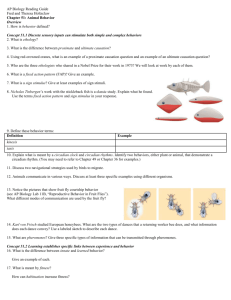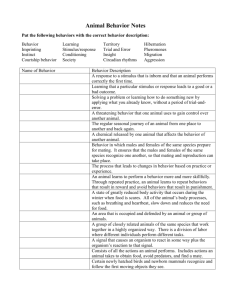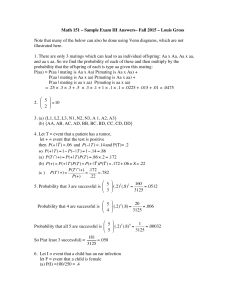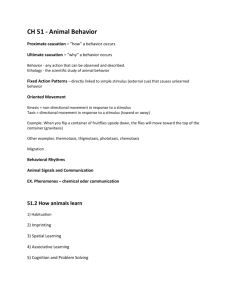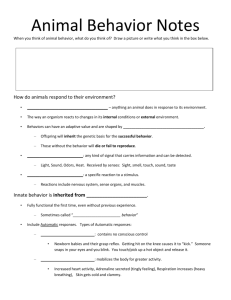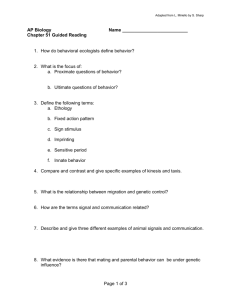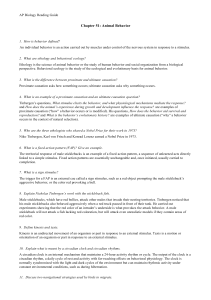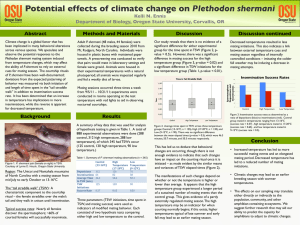File ap notes chapter 51
advertisement
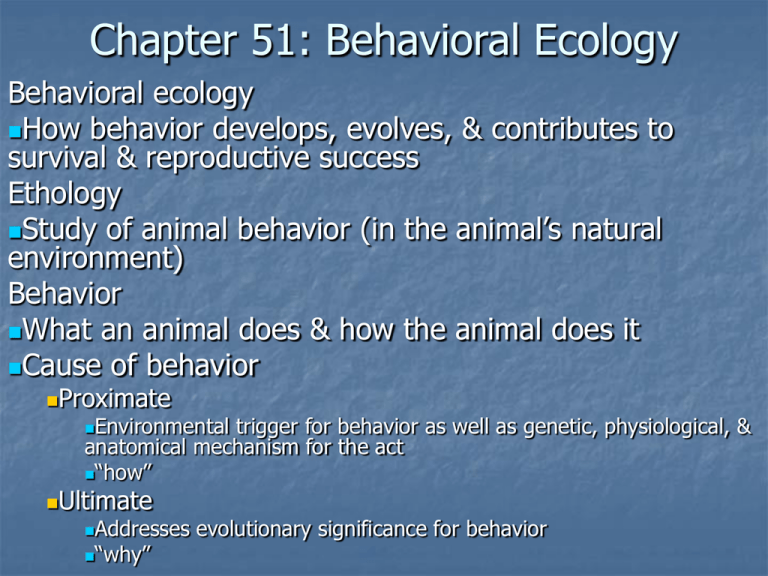
Chapter 51: Behavioral Ecology Behavioral ecology How behavior develops, evolves, & contributes to survival & reproductive success Ethology Study of animal behavior (in the animal’s natural environment) Behavior What an animal does & how the animal does it Cause of behavior Proximate Environmental trigger for behavior as well as genetic, physiological, & anatomical mechanism for the act “how” Ultimate Addresses “why” evolutionary significance for behavior Types of behavior Instinct Inherited behavior; developmentally fixed Examples: Directional movements Kinesis- change in activity or rate in response to a stimulus (ex. sow bugs more active in humidity) Taxis- oriented movement toward or away from a stimulus (ex. Trout face current) Migration (ex. Migratory restlessness in blackcap birds) Animal Signals & Communications Signal=behavior that causes a change in another animal’s behavior Communication= transmission of, reception of, & response to signals visual Tactile electrical signals Chemical Releaser Pheromones- cause immediate behavior change Primer pheromones- cause physiological change Auditory which communication is used is dependant on animal’s environment & lifestyle Fixed Action Patterns Sequence of unlearned, unchangeable behavioral acts carried out to completion once initiated Triggered by sign stimulus (external sensory stimuli) Ex. Male stickleback fish aggressively defends territory when triggered by red color Imprinting Behavior that involves learning & innate components & is irreversible Sensitive period: Brief period in which behavior can be learned (typically from parent) Ex. Graylag gosling accept any moving object as mother during 1st 2 days Learning Modification of behavior based on specific experiences Habituation loss of responsiveness to stimuli that convey little or no information “cry-wolf” effect Spatial Learning Modification of behavior based on experience with spatial structure in the environment (location of nest, hazards, food, mates) Use landmarks as location indicators Cognitive maps Internal representation/code of the spatial relationships between objects in an animal’s surroundings Associate learning Ability to associate one feature of the environment (stimulus) with another (the response it produced) Classical conditioning- stimulus is associated with a reward or punishment Operant conditioning/trial & error learning- animal associates one of its own behaviors with reward or punishment Cognition & problem solving Ability of an animal’s nervous system to perceive, store, process, & use information gathered by sensory receptors **Natural Selection can act on behavior that has a genetic component Behavioral Variation can exist in prey selection aggressive behavior Parental care Migratory patterns **Natural selection most often acts on behaviors that increase survival & reproductive fitness…. Foraging behavior Mating behavior & choice Foraging Behavior Optimal foraging theory food obtaining behavior is a compromise between the benefits of nutrition & the cost of obtaining food Costs include- energy expenditure, risk of own predation Examples: Northwestern crows flying up to break open shells of molluscs Bluegill sunfish selecting larger vs. smaller crustaceans Mule deer feeding in open areas vs. forest edges Mating Behavior & Mate choice Mating relationships Promiscuous- no pair bonds Monogamous- single pair bond; no dimorphism Polygamous- sexual dimorphism Polygyny- one male mating with several females; male ornamented Polyandry- single female mating with several males; female ornamented Need for parental care & certainty of paternity influence mating behavior Sexual selection & mate choice Intersexual selection Female preference for a male mating behavior or anatomy influences that behavior or anatomical structure’s rate of occurrence Female prefer traits that signal male quality/health Intrasexual selection Male competition for mates Agnostic behavior- ritualized contest that determines which male gains access to the resource Game Theory Different strategies effectiveness may vary based on environment & strategies of other individuals Ex. Ispod Paracerceis sculpta alpha, beta, & gamma males; orange, yellow, & blue throat lizards Social Behavior & altruism “Selfish” behavior can be explained by natural selection Altruism: selflessness; animal behaves in such a way that decreases its own fitness but increases the fitness of others in the population Examples: Belding’s ground squirrel’s alarm call Worker bee sterility; sting & die Naked mole rats protecting queen & kings Inclusive fitness: total effect an individual has on proliferating its genes through its own offspring or through a relatives offspring rB>C favors altruistic behavior where: r= coefficient of relatedness B= benefit to the altruistic behavior (average # offspring that will be produced as a result) C= cost of altruistic behavior (average # of offspring that will not be produced as a result) Kin selection Reciprocal altruism Individual acts to enhance the reproductive success of relatives improves the chance that genes the same as his/her own are passed on Altruistic individual aids a non-relative with “hope” that the favor will be returned in the future Found most often in highly social species in which “cheating” would lead to negative consequences “tit for tat” Social Learning Learning through observing others Culture: system of information transfer through social learning or teaching of individuals in a population Example: Vervet monkey alarm calls Sociobiology: study of human culture & its relationship to evolutionary biology

